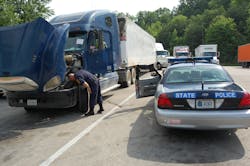Experts are urging fleets to revisit their safety strategies as truck safety enforcement efforts continue to intensify at the local, state and national levels.
Indeed, the new Compliance, Safety, and Accountability (CSA) program introduced by the Federal Motor Carrier Safety Administration last year is already helping reduce trucking capacity, argued Rosalyn Wilson, senior business analyst with Declan Inc. and primary author of the annual State of Logistics report, recently – emphasizing that many shippers continue to reevaluate their carriers using CSA and are dropping carriers with high scores.
“This leaves carriers that may already have been strained by the recession with lower revenue expectations, reducing their ability to fix their fleets to lower their [CSA] scores,” she explained during the presentation of the 23rdannual State of Logistics report last week.
“On average, LTL carriers have tended to have worse CSA scores than carriers in general and this virtually whittled the carrier selection down to a couple dozen possibilities,” Wilson pointed out. “The prospect for liability litigation has been at the forefront of these decisions.”
She noted that many freight agreements now include clauses requiring carriers to use trucks that have passed inspection for their shipments and to have a plan for remediating their CSA scores. “Usually there are checkpoints for the carrier and if the goal has not been met their agreement can be terminated,” Wilson said.
That’s why many industry experts believe fleets across the trucking spectrum need to refocus on the safety “basics” not only to stay in compliance but keep their bottom line intact as well.
“It’s all about the basics,” Andrew Leavitt, senior manager for safety at Ryder System, explained to Fleet Owner. “The level of accountability now is also not just about regulatory compliance; it impacts the cost of doing business and the general public as well.”
In a recent white paper Ryder published entitled 5 steps to creating a safety driven culture, Leavitt and Frank Spingola, Ryder’s group director of safety, noted for example that the average cost of one truck-involved accident can be more than $90,000. Even at a profit margin of 5%, a company would need to generate an additional $1.8 million in revenue to recover its costs from that one accident, Spingola said.
“Unsafe driving practices have both human and business impacts,” he pointed out. “First of all, the costs can be staggering, mandating huge increases in revenues just to offset the cost of the crash. However, the primary reason to embrace safety is to minimize or prevent personal injury, vehicle collisions and property damage.”
Spingola argues that failure to implement and follow safe business practices can also negatively impact a carrier’s reputation and business results. However, conversely, a culture of safety can help minimize incidents and comply with tougher federal, state and local regulations – saving money, protecting the public, and burnished a carrier’s reputation in the bargain as well.
“With all the business pressures out there, trying to operate in these tough economic times, it’s tempting not to invest fully in safety,” he said. “But if you integrate safety as a core value into your company, if your top executives are committed to it and hold the organization accountable to its safety principles, then you will save money on several levels.”
Indeed, many carriers are undertaking such a “refocusing” on their safety programs, according to data gathered by Transport Capital Partners (TCP) in a recent survey.
TCP’s poll showed that most carriers are employing several methods to ensure compliance with CSA, with over 78% focusing on employee training to help them understand how CSA will affect their career. Another 63% are focusing on changing the behavior of sub-performing drivers, while 55% are investing in new technology to help monitor equipment and drivers, TCP said.
Ryder’s Spingola also argues that fleets should welcome the intensification of safety enforcement efforts being driven by CSA, too. “If you get a reputation for being ‘good’ in terms of CSA compliance, it will give you a competitive advantage,” he explained.
About the Author
Sean Kilcarr
Editor in Chief
Sean Kilcarr is a former longtime FleetOwner senior editor who wrote for the publication from 2000 to 2018. He served as editor-in-chief from 2017 to 2018.
